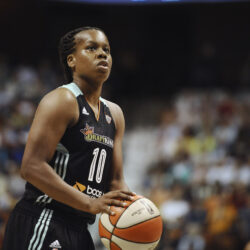
Merce Cunningham: Legacy Tour

Is there anything left to say? That’s the question I asked myself as I watched one of the seminal companies of the 20th century on the final leg of its final tour — the Merce Cunningham Dance Company at the Brooklyn Academy of Music, where Cunningham first performed with musician John Cage in 1952.
Another critic, seated next to me, said she had come simply to pay her respects. Clearly, so had many in the audience. Middle-aged and older audience members clearly knew the work. Parents brought their young dancers to give them a chance to see an original before it became history. I had my own reasons for being there.
A confession: As a child I made up stories to put myself to sleep. By my pre-teens, stories of princesses segued to dancing. Long before I ever saw Cunningham, one story had me as a member of the company. “Merce” would discover me rehearsing my own choreography. My career was made. Of course this never happened.
My first Cunningham was an Event — performances of excerpts of repertory, arranged into new sequences for a particular performance and place. Separate activities often happen at the same time in order to “allow not so much an evening of dance as the experience of dance,” as explained by Cunningham.
Held in the big gym at UCLA where I was a student — home to the then-legendary Bruins — so much happened at once that I could barely take it in. No matter, I was fixated by Merce with his straight spine, quick, sharp legs and decisive arms, his curly head tracking slowly taking everything in as the company, who he called “the life of my work,” darted and leaped around him.
When watching his last company at BAM, this “life” was evident, as each performer channeled Cunningham’s distinctive style through his or her unique body and approach. The company has spawned more than its share of innovators.
An early contact improviser in Chicago, I had been introduced to the form by its founder, Steve Paxton (Cunningham company member from 1961-64). Like so many, I studied with Viola Farber (1953-65) and took a class with Valda Setterfield (1965-75). Jim Self (1977-79) established the performance loft in Chicago where I rehearsed and performed. Tricia Brown (who trained with the company), Deborah Hay (1964) and Douglas Dunn (1969-73) remain important to avant-garde dancers and scholars. More recently Jonah Bokaer (2000-2007), a choreographer in his own right, created two Brooklyn dance spaces that have provided performance homes to many. Among the list of current and former company members, I count nearly 20 others that I have studied with, interviewed, reviewed and become friends with, artists whose work covers a huge range of aesthetics and ideas — even one who went to high school with my mother.
Unlike the chaos surrounding the death of Cunningham’s modern dance predecessors, with typical precision, and in consultation with many, Cunningham created a Legacy Plan. Following a two-year grand tour, the company is disbanding. Funds have been provided to help dancers, musicians and staff transition to their next phase. The Merce Cunningham Trust will manage his artistic legacy licensing and remounting his work with the aid of former company members. Although the company’s long-term Westbeth home, in which so many dancers trained and aspiring choreographers presented, is no longer, his technique will continue through Trust-arranged classes around New York City.
As one of the last stops on the Legacy tour, BAM hosted three programs. I have always loved “Rainforest” (1968). The movement is accompanied by an Andy Warhol installation called “Silver Clouds,” in which floating silver pillows, aloft with helium, spill into the audience, leading to sudden games of keep-away. The pillows contrast dramatically with the precise, rigorous rectangularity that defines much of Cunningham’s early work. Sweeping ronde de jambes carry the dancers across the stage, while the severity is broken by the flying pillows they kick out of their way.
“Split Sides” (2003) exposes Cunningham’s sometimes mysterious and certainly iconic “chance method.” The order of the two sets of décor, music, costumes and movement sequences were chosen each night by tosses of dice in full view of the audience. Traditionally done off-stage, “Split Sides” reveals the possibilities created through random connections. Both “Split Sides” and especially “Pond Way” (1998), which rounded out the evening, are more flowing than Cunningham’s earlier work. Unleashing his dancers, Cunningham sends them scooting and sliding across the floor in wide, unhurried floor patterns, dotted with dramatic shapes, holds and balances.
My body still feels the unmistakable technique learned in college classes and brief stints at Cunningham’s studio. Movements that are indelibly his — quick, decisive passés, straight side-tilts, arms that curve crisply overhead, non-luxurious, small, upper back arches, over-curve leaps that push off the ball of the foot, brisk, high, no nonsense battements, tight, nearly ridged chaîné turns, side-ways triplets, and jumps with legs pulled tightly underneath like a frog — pop out at me like old friends.
If it must end, it’s hard to imagine a more glorious ending than Merce imagined for himself. Looking forward and back, emotional while not emotive and, above all, personal. I leave the company full circle with the Park Avenue Armory Events. Six affordably priced ($10) evenings, designed by Cunningham as part of the Legacy Plan, closed the two-year tour. I saw number four.
Three large platforms set in a triangle dominated the cavernous Armory; each had a small number of seats nearby. Additional raised viewing platforms made all stages easily visible, and the audience was invited to wander and watch from many vantage points. Dancers chose segments of their favorite dances to perform in the course of the evening. Sometimes the movement seemed disparate, separate but equal. At others — and here is Cunningham’s magic — they came together is if they had always been that way. Robert Swinston, director of choreography, performed bits of “Antic Meet,” Cunningham’s iconic 1958 chair dance, revived for this farewell tour.
Visual components paid tribute to company history. Overhead billowed clouds, gatherings of 20,000 polyethylene balls in shades of gray by Daniel Arsham based on photographs of clouds he took on tour with the company. Unitards in a range of blues bore designs created from photos taken from Westbeth’s windows. The music, composed and played live by the MCDC Music Committee — Takehisa Kosugi (music director,) David Behrman, John King and Christian Wolff — was performed on a fourth rectangular platform on the north end of the space. High above on the Armory balcony were six brass players— trumpeters and sax players whose sound called the audience to attention like a shofar on Yom Kippur. My husband, a trained musician, was thrilled.
At BAM the company seemed a bit rough, perhaps exhausted from months of touring, though individually there were stellar performances. In the Armory, the relationships and strengths of the dancers were fully evident. Andrea Weber’s beautiful clarity and length of line; Rashaun Mitchell’s solid leadership and unusually fluid approach to Cunningham’s movement; Daniel Madoff’s curly hair, slim physique and crisp movement conjured the choreographer. Jennifer Goggans’ striking attack and precision was achingly lovely.
I noticed something I’d forgotten about Cunningham. His male dancers, as he was before them, are unfailingly gracious partners. There is something courtly about the way each places a hand on a partner’s back, the way they physically escort female partners to a new place, an echo of old ballet tradition in this (still) most modern of choreographers. This is about the man Cunningham was. A visionary whose early work was sometimes considered mechanical, anti-human, and yet whose humanity is evident in attention to such small details.
By accident I was standing at the foot of one of the platforms as the Event ended. After many bows to every side of the room, a tired but happy-looking group of dancers filed through a gauntlet of still clapping admirers. The applause was for them, and for the man that changed the way we think about dance.
For more information go to www.merce.org.
Leave a Comment
Leave a Comment


